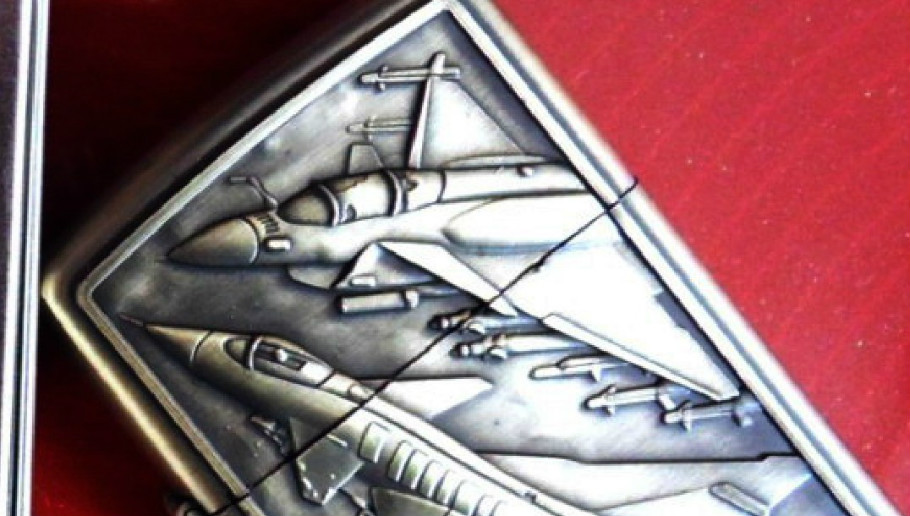J-10B Vigorous Dragon/Firebird
A
J-10B (K/JJ10B?) multirole fighter was photographed in the sky over Chengdu before it was handed over to PLAAF. This much improved variant made its maiden flight on December 23, 2008, powered by a Russian AL-31FN engine (1031 prototype).
The improvements include a
DSI/"Bump" inlet which not only cuts weight but also reduces RCS, after a similar design was first tested onboard
FC-1/JF-17. The aircraft also features a new indigenous IRST/LR in front of the canopy, a white IFR probe light on the starboard side of the nose, a
JF-17 style
glass cockpit with a wide-angle holographic HUD, three large color MFDs and an HMDS.
The new IRST allows passive detection of enemy aircraft, making
J-10B more stealthy in combat. Its nose appears flatter too, similar to that of American F-16, housing a new fire-control radar which is thought to be an X-band
PESA developed by the 607 Institute (track 10, engage 4 simultaneously), the first of such type ever being developed for a Chinese fighter aircraft, giving
J-10B a stronger multi-target engagement and ECCM capability.
It was rumored that initially the aircraft was planned to be fitted with an AESA developed by the 14th Institute but the radar was not ready by the time the aircraft was ready for production. An ECM antenna can also be seen right in front of the canard foreplane on the 1035 prototype.
The tip of vertical tailfin was redesigned as well, featuring a long compartment housing communication and ECM antennas, which resembles that of French Mirage 2000. A rear facing MAWS sensor can be seen underneath the parachute boom. A similar system was tested onboard
FC-1/JF-17.
RAM coating is also expected in certain areas such as engine inlet and wing leading edges to reduce RCS.
All these improvements suggest that
J-10B is equipped with a new generation of integrated electronic system connected via an optic HSDB, ranging from radar to EW system.
Its mission may be changed from air-superiority to multi-role, such as CAS or EW. For air-superiority mission, normally
6 AAMs (PL-12x4 + PL-8x2 or
PL-10x2, PL-12s are carried underneath the dual missile launch rails) are carried. For CAS missions, normally 2 KD-88 AGMs, or 2 LS-500J LGBs, or 2 new
GB1/TG500 500kg LGBs can be carried. 2
YJ-91s can be carried for SEAD mission.
The laser designator pod is thought to be K/JDC01A . A
KG600 ECM pod can also be carried underneath the engine air intake for enhanced EW capability. Overall
J-10B is thought to be comparable to American F-16E/Block 60. The 03 prototype (1033) first flew in August 2009, with the pitot tube removed from the nose tip. Both 1031 & 1034 prototypes were tested at CFTE.
An indigenous
WS-10B turbofan engine was tested for some time on 1035 in 2011 but did not proceed forward.
J-10B is likely to serve as a testbed for various advanced technologies adopted by the 4th generation
J-20 currently under development at CAC thus may not enter the service in large quantity with PLAAF.
In March 2013 the
1031 prototype was seen with ECM antennas installed ahead of the canard foreplanes similar to those onboard 1035, which represents the final configuration before the production. The production of
J-10B finally started in 2013 after the delivery of a new batch of AL-31FN Series 3 engines (13.7t with A/B). By May 2015 around 53 01 batch
J-10Bs had been produced and the delivery started in 2014, possibly to the PLAAF Flight Test & Training Base, PLAAF 2nd Division and 21st Division (S/N 78x1x, 10x3x, 3xx0x, 30x2x,
78x7x?).
Meanwhile a further upgraded variant (
J-10C) with an AESA radar was under development (see below). Recent images (September 2015) indicated that the improved WS-10B turbofan with FADEC has been installed onboard the last two
J-10Bs of the 01 batch (#0155 & 0156, S/N 78x1x?), suggesting the engine has finally overcome the reliability issues and is ready to power the remaining batches of
J-10Cs.
J-10B was officially unveiled at the 2016 Zhuhai Airshow, carrying dual PL-12 missile launch rails.
- Last Updated 1/17/17
 J-10C Vigorous Dragon/Firebird
J-10C Vigorous Dragon/Firebird
It was first rumored in June 2013 that a "full standard" variant (
J-10C) with enhanced 4th generation electronics including an
AESA radar, which is finally available, was under development. The
J-10C(K/JJ10C?) #201 prototype (later renumbered as
#1051) took to the sky for the first time on December 31, 2013, powered by an AL-31FN Series 3 engine.
The aircraft appears to have close similarity with
J-10B except for an additional
datalink antenna on its spine ahead of the vertical tailfin. The aircraft is capable of firing the latest PL-10 and
PL-12G AAMs. It was speculated that the 02 batch would be
J-10Cs instead of
J-10Bs.
Recent images taken in November 2015 indicated that the production of the 02 batch has begun. They are thought to be
J-10Cs with VLOC antennas installed on top of the vertical tailfin and without the rear MAWS sensors on the tail (reason unknown). The aircraft is still powered by AL-31FN Series 3 turbofan and it is unclear when WS-10B will be fitted. Recent images (February 2016) indicated that
J-10C is getting ready to enter the service with PLAAF Flight Test & Training Base (S/N 78x1x? 78x7x? 5xx5x?).
The latest rumor (April 2016) suggested that 611 is developing another upgraded variant (J-10D?) which might feature CFTs to increase its range as well as a more powerful WS-10IPE (14t class?) turbofan engine with a stealth nozzle toreduce its radar and IR signatures.
- Last Updated 12/6/16
Source :
http://chinese-military-aviation.blogspot.co.id/p/fighters-ii.html
Hope it can help you. 








